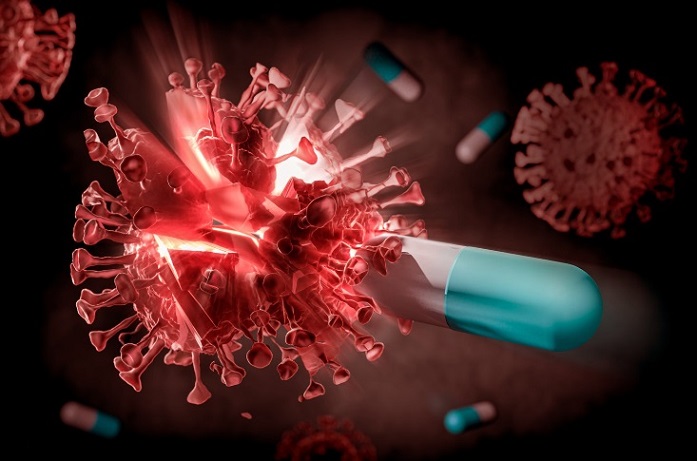Nikhil Prasad Fact checked by:Thailand Medical News Team Jan 20, 2025 2 months, 3 weeks, 3 days, 8 hours, 44 minutes ago
Medical News: Proteolysis-targeting chimeras (PROTACs) are emerging as an innovative frontier in antiviral treatments. These heterobifunctional molecules function by degrading target proteins via the ubiquitin–proteasome system. Unlike conventional inhibitors, PROTACs operate catalytically, enabling efficient target protein degradation even at very low concentrations. They are effective in nanomolar to picomolar ranges and exhibit superior target selectivity.
 PROTACs, New Antiviral Approach to Combatting Viruses
PROTACs, New Antiviral Approach to Combatting Viruses
The mechanism of action involves leveraging the cell's ubiquitin-proteasome system (UPS) to bring the target protein into close proximity with an E3 ligase. The process begins with E1 activating and transferring ubiquitin to E2. Subsequently, E2 interacts with the E3 ligase, which identifies the target protein and attaches ubiquitin to it. As the ubiquitin chain elongates, the target protein is marked for degradation and ultimately broken down by the 26S proteasome. PROTACs exploit this system by facilitating the interaction between the target protein and the E3 ligase, thereby promoting degradation. Notably, PROTACs function catalytically, allowing the molecule to be recycled and used repeatedly after the degradation of the target protein.
Developed to overcome the limitations of traditional therapies, PROTACs leverage the ubiquitin-proteasome system to degrade specific viral proteins. Unlike standard antivirals, which primarily inhibit viral functions, PROTACs use a bifunctional molecular design to identify and eliminate essential viral proteins. This revolutionary approach could redefine how we combat persistent and evolving viral threats.
Researchers from institutions such as Dr. D. Y. Patil Institute of Pharmaceutical Sciences and Research (Pimpri, Pune, India), SSR College of Pharmacy (Silvassa, India), and the Goa College of Pharmacy (Goa University, Panaji, India) are at the forefront of this groundbreaking research. This
Medical News report highlights their key findings and the transformative potential of PROTACs in managing viral diseases.
Addressing Global Viral Challenges
Viral infections, including chronic illnesses like HIV and hepatitis, and emerging diseases such as SARS-CoV-2, pose a monumental challenge to global health.
Conventional therapies, ranging from antiretrovirals to vaccines, have demonstrated varying levels of efficacy but are often hindered by viral resistance, high mutation rates, and adverse effects from prolonged use. For example, HIV’s ability to rapidly mutate has led to resistance against antiretrovirals, while hepatitis viruses remain resilient despite interferon-based treatments.
PROTACs offer a promising alternative by degrading a wide range of viral proteins - even those previously considered “undruggable.” By binding to target viral proteins and E3 ligases, these bifunctional molecules form ternary complexes that tag the proteins for destruction. This catalytic mechanism allows one PROTAC molecule to target and degrade multiple copies of a viral protein, potentially enhancing
therapeutic efficacy and minimizing required dosages.
Breaking Through “Undruggable” Barriers
Traditional antiviral agents struggle with “undruggable” targets - viral proteins that lack defined binding sites. PROTACs overcome this limitation by facilitating targeted protein degradation. In the context of HIV, PROTACs designed to target proteins such as integrase and Tat have shown potential in disrupting viral replication cycles. Similarly, PROTACs targeting the HBx and NS5A proteins in hepatitis B and C have demonstrated efficacy in reducing viral persistence and resistance, offering hope for more durable treatments.
Emerging Applications and Preclinical Success
While no PROTAC-based antiviral therapies have reached clinical approval, preclinical studies show promise. For example, the Goracci group’s Indomethacin-based PROTACs demonstrated strong inhibitory activity against various coronaviruses. Similar studies targeting the H5N1 influenza virus suggest PROTACs could serve as broad-spectrum antiviral agents, selectively degrading critical viral components to halt replication.
Broad-Spectrum Potential
PROTACs’ ability to target conserved viral proteins makes them candidates for broad-spectrum antiviral therapy. For instance, PROTACs targeting the dengue virus envelope protein (E) have shown activity against mosquito-borne flaviviruses like Zika and Japanese encephalitis. These treatments inhibit viral entry and enhance particle degradation, providing a pathway for combating drug-resistant viruses.
In the fight against human cytomegalovirus (HCMV), PROTACs leveraging cyclin-dependent kinase inhibitors have shown unique modes of action, addressing unmet medical needs. Similarly, in monkeypox and Ebola, targeting essential proteins like DNA polymerase and VP35 respectively could provide effective therapeutic solutions.
Enhancing Vaccine Development
Recent research explores PROTAC technology in live attenuated vaccine development. By degrading essential viral proteins, PROTACs create safer vaccine candidates that retain the ability to stimulate immune responses. For instance, PROTAC-based influenza vaccines have demonstrated strong immune activation in animal models, paving the way for safer and more effective vaccines.
Challenges and Future Directions
Despite their promise, PROTACs face significant challenges. Their bifunctional nature, while enabling precise targeting, raises concerns about off-target effects, potentially leading to toxicity. Researchers are actively working to improve PROTAC specificity and minimize unintended interactions.
Pharmacokinetics also present a hurdle. Due to their large molecular size, PROTACs may face bioavailability and tissue penetration issues. Advances in nanoparticle delivery systems and structural optimization are being explored to address these limitations. Ethical considerations, including the potential impact on viral evolution and patient safety, must also be rigorously evaluated in preclinical and clinical trials.
Conclusion
PROTACs represent a transformative shift in antiviral therapy, addressing challenges that have long limited conventional treatments. By degrading “undruggable” proteins, PROTACs can disrupt viral replication at multiple stages, offering hope for combating resistant and emerging viral threats. The ability to target conserved viral proteins positions PROTACs as powerful tools for broad-spectrum therapies and rapid pandemic response. Ongoing advancements in linker chemistry, delivery systems, and safety optimization could unlock the full potential of this innovative technology. With continued research, PROTACs may revolutionize the treatment landscape, providing a versatile and effective platform for next-generation antiviral therapies.
The study findings were published in the peer-reviewed journal: Future Medicinal Chemistry.
https://www.tandfonline.com/doi/full/10.1080/17568919.2025.2453418
For the latest on Antivirals, keep on logging to Thailand
Medical News.
Read Also:
https://www.thailandmedical.news/news/pateamines-new-antiviral-agents-in-the-fight-against-coronaviruses-and-even-flu-viruses
https://www.thailandmedical.news/news/herbs-and-phytochemicals-study-uncovers-antiviral,-anti-inflammatory,-anticancer-and-neuroprotective-effects-of-pinostrobin-from-carya-cathayensis
https://www.thailandmedical.news/news/natural-indoles-from-the-gardneria-multiflora-makino-plant-emerging-as-potential-antiviral-agents-against-hiv-and-hcv
https://www.thailandmedical.news/news/russian-antiviral-drug-ingavirin-found-effective-against-human-metapneumovirus-insights-from-a-2012-study
https://www.thailandmedical.news/news/the-broad-antiviral-potential-of-the-tcm-decoction-fuzheng-jied-against-various-coronaviruses-including-sars-cov-2
